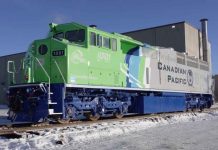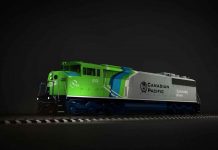
Hydrogen Powered Rail is Not a Pipe Dream
THUNDER BAY – Transportation – Hydrail—hydrogen fuel cell railway traction—has been a long time in coming to Thunder Bay. Down here in North Carolina we’ve been (in spirit) up there on the platform beside y’all, glancing at our watches and peering down the track, ever since Premier Dalton McGuinty called the train back in 2007.
But I just may have heard a faint whistle in the distance. And I can imagine that hydrail may yet make it from Bombardier’s Montreal Headquarters to Thunder Bay…via Qingdao, China!
On 23 September 2016, while I was in Germany for the prototype roll-out of the first full-scale hydrail passenger train, Bombardier Transport was inking a strategic cooperation agreement with China Railway Rolling Stock Corporation (CRRC). Bombardier and China have been partnering since at least 1998 when Bombardier Sifang (Qingdao) Transportation Ltd. was formed. Today, after several mergers and organization changes, CRRC has two hydrail tram plants in production, Sifang Qindao and Tangshan Railway Vehicle Co Ltd !
Hydrail – A Paradigm Shift
The railway traction paradigm shift I proposed at the invitation of the US Department of Transportation’s Volpe Center in August, 2003, is now well under way. Four German States—Niedersachsen, Nordrhein-Westfalen, Baden-Württemberg and Hesse—will have a fleet of at least forty Alstom Transport Coradia iLint trains deployed by the end of this decade.
By 2025, a fifth German State, Schleswig-Holstein, plans to have its entire rail network electrified, using its existing catenary system (35%) and replacing all its diesel trains with hydrail (65%).
S‑H trains will run like the wind—or rather run on the wind. The Land has a bountiful surplus of wind turbine electric power during off-peak hours. This will be electrolyzed into hydrogen for the zero‑carbon hydrail fleet and maybe, eventually, to feed the catenary trains as well.
Another great idea from Schleswig-Holstein is to hold an annual German Regional Hydrail Conference to plan and sequence the transition off diesel.
This is an idea Canada could borrow
There is good reason to anticipate that all of Germany will go hydrail in the foreseeable future. The Bundesrepublik recently chartered an Ernst and Young study to look into it and the results, announced on 1 July 2016, were favorable. German Transport Ministry State Secretary Ranier Bomba said, “…electric railcars can be a low emission alternative to diesel operations. We want to support this development. For this reason we have made rail transportation a focus of funding in our National Innovation Programme.”
Canada – A Hydrail Super Power
For over a decade, from south-of-the-border, I’ve viewed Canada as the hydrail “super power” of this hemisphere. You co-funded the very first hydrail locomotive, the Little Workhorse mining locomotive, and tested it in Val D’or, Quebec. The Fraser Valley Heritage Railway Society, and its engineering leader, Peter Holt, inspired to a very great degree our creation of the annual International Hydrail Conferences.
Even if commercial hydrail was not born in Canada, it was indisputably conceived under the Maple Leaf. It was in Toronto, at Ryerson University, under the leadership of Canadian Robert Stasko, that Canada’s Hydrogenics Inc. of Mississauga engaged France’s Alstom Transport in the project that’s just yielded the history-making Coradia iLint hydrail train fleet in Germany.
Hydrogenics Inc. and Ballard Power Systems, both Canadian, power almost all the hydrail rolling stock in the world. Dr. Alistair Miller of Canadian Nuclear Laboratories was the prime mover in Mooresville’s decision to pursue our Hydrail Initiative. Canada has far more hydrail bragging rights than I can squeeze into one essay.
Finally, James Murray of the NetNewsLedger has been a continual inspiration to us all in keeping alive the vision of Bombardier in Thunder Bay as “Hydrail Central” for the Americas!
So, though mindful of the Boy Scout who took twenty minutes to help the old lady cross the street because she didn’t want to go, I’m having a foreigner’s go at flogging the notion of a Canadian National Hydrail Conference. I’d rather be an intruding busy-body than miss a chance to offset some of the USA-as-isolationist miasma that’s been in the air of late.
To any who read this and agree: please talk it up! As a climate protection authority, Ontario’s Hon. Glen Murray—one of our keynote speakers at the Eighth International Hydrail Conference where commercialization finally took off—could be an idea leader to help spark the Conference idea.
Stan Thompson




